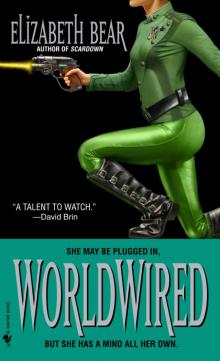- Home
- Elizabeth Bear
Machine
Machine Read online
Thank you for downloading this Simon & Schuster ebook.
Get a FREE ebook when you join our mailing list. Plus, get updates on new releases, deals, recommended reads, and more from Simon & Schuster. Click below to sign up and see terms and conditions.
CLICK HERE TO SIGN UP
Already a subscriber? Provide your email again so we can register this ebook and send you more of what you like to read. You will continue to receive exclusive offers in your inbox.
Publisher’s Notice
The publisher has provided this ebook to you without Digital Rights Management (DRM) software applied so that you can enjoy reading it on your personal devices. This ebook is for your personal use only. You may not print or post this ebook, or make this ebook publicly available in any way. You may not copy, reproduce, or upload this ebook except to read it on your personal devices.
Copyright infringement is against the law. If you believe the copy of this ebook you are reading infringes on the author’s copyright, please notify the publisher at: simonandschuster.biz/online_piracy_report.
For Chelsea
The incredible thing was that the machine smiled, smiled perpetually.
—from The Trembling of the Veil, W. B. Yeats, 1922
Man, with his singular laughter, his droll tears,
His engines and his conscience and his art,
Made but a simple sound upon your ears:
The patient beating of the animal heart.
—from Sonnet IV, Wine from these Grapes: Epitaph for the Race of Man, Edna St. Vincent Millay, 1934
CHAPTER 1
I STOOD IN THE DOOR AND looked down.
Down wasn’t the right word, exactly. But it also wasn’t exactly the wrong word. All directions were down from the airlock where I stood, and almost all of them were an infinitely long fall.
I wasn’t only staring into bottomless space. I was aiming: aiming at a target that wheeled sickeningly less than a klick away. My own perch was also revolving around a central core, simulating a half a g or so, just to keep things interesting.
I was standing in the airlock door because I was going to jump.
Just as soon as I got my bearings and my timing.
I don’t get to be afraid now. I get to be afraid before and I get to be afraid after. But I don’t get to be afraid during.
There’s no room during for being afraid. So I have to fold the fear up. Tuck it out of sight and get on with all the important things I am doing.
In this case, saving lives and making history. In that order of priority and the reverse order of chronology.
I hoped to be saving lives, anyway, if I got lucky and there were still some lives on the other side of my jump to save.
Across that gulf of vacuum lay the ancient ship we pursued. It wasn’t far, by space travel standards. A few hundred meters, and it seemed like less, because Big Rock Candy Mountain was thousands of meters in diameter.
I say “ship.” But what I was looking at was an enormous wheel whipping around its hub as if rolling through space. It was a station orbiting no primary; an endless scroll of hull unreeling—subjectively speaking, because on my own ship I felt like I was standing still—in a spring-curl spiral twisting around us.
Not a smooth hull, but a rocky and pockmarked one. One punctured by micrometeors and crumpled by sheer stresses. With bits of structure projecting from the surface at varied angles and its cerulean and gold paint frayed by unfiltered ultraviolet and abraded by space dust.
Big Rock Candy Mountain was old.
About six hundred ans old, to be as precise as I could without running a lot of fussy conversions in my head. She’d come from Terra in the pre-white-drive era, and over the centians she had built up tremendous velocity.
She was zipping along at a solid fraction of the speed of light, out here in the dark places between the stars, much farther from home than she could have possibly been, her course no longer anything like the original plot retrieved by Core archinformists.
Maybe she’d gotten lost, or an impact that had caused some of the damage to her hull had knocked her off course. Or maybe the people who had outfitted her had lied about where they planned to go. The era of Terra’s history that had spawned sublight interstellar exploration and the generation ships had not been one of trust and peaceful cooperation between peoples. More one of desperate gambles and bloody-nailed survival.
Only one generation ship had ever reached a destination as far as history was aware, and that hadn’t ended well. We were here because this one had sent out a distress signal, and a Synarche ship, tracing it, had found her. And sent out a data packet requesting assistance on Big Rock Candy Mountain’s behalf.
The Synarche ship had not been in contact since, which was disconcerting. And its locator beacon, and Big Rock Candy Mountain’s distress signal, were still beeping away down there. And so we were here: to see if we could rescue anybody. If there was anybody left to rescue.
It didn’t look promising. The ship behind us was another ambulance, but the one after that contained a team of archaeologists and archinformists, and I had an unsettling premonition that there was going to be a lot more useful work for them to do than for us. I wasn’t sure exactly how far behind us they were, but I expected we were on our own for at least five to ten diar. The rescue could not afford to wait for backup.
There could be people alive in there. We had to proceed as if there were, until we had proven otherwise. But they’d done nothing to acknowledge our approach, and they had not responded to hails on the same frequencies as their distress beacon.
I couldn’t have preconceptions, because I couldn’t afford to miss anyone who might be alive. Nevertheless, contemplating the vast ruin before me made me feel sad. Worse, it was that creeping, satisfying sadness you get when you look on a ruin: at something long destroyed, something lost that isn’t your problem.
My own ship, Synarche Medical Vessel I Race To Seek the Living, was an ambulance associated with Core General. She had spent nearly a standard month with her modern engines burning fuel recklessly to match velocity with Big Rock Candy Mountain. Sally—as we called her—was fast, maneuverable, and had outsize sublight engines for her mass. She also had an Alcubierre-White drive for FTL travel, though since it didn’t impart any actual velocity to the ship, it couldn’t be used to chase down quarry in normal space. We’d had to slingshot the big gravity well at our origin point in the Core to accelerate, then conserve momentum through the transition in order to catch the speeding generation ship.
I say “slingshot” like it was a routine maneuver. In reality, there’s nothing quite like staring into the most enormous black hole in the galaxy, then flying right down its gullet like a gnat with attitude. (Inasmuch as anybody can stare into an actual black hole with their actual eyes unless they belong to one of the exotic species that can visualize X-rays or radio waves.)
So we’d already had one adventure leaving the Core, and now here we were. We weren’t docking with Big Rock Candy Mountain. We had no information about the structural integrity of this antique hulk, but common sense suggested it would be fragile. Unbalancing it, subjecting it to the stresses of docking—both were terrible ideas. We’d have to use one of our adaptable docking collars anyway, because the idea that our hardware and theirs would be compatible was laughable.
That’s why I was jumping.
It was not as dangerous as it probably seems. I’m Sally’s rescue specialist: getting people out of dangerous situations is my job, and I do this sort of thing frequently.
The insertion can be dicey, though.
My hardsuit had jets, so I had maneuverability. And everything in space is moving incredibly fast anyway, so what matters is the relative velocity. If you and I are moving at the same speed in
the same direction and there’s nothing else around us, we’re functionally not moving.
Space has a whole lot of nothing. If I jumped at the right time, and corrected for Sally’s rotation, all I had to do was match velocity with the wheel and snug down onto it.
It was still breathtaking to stand inside that open airlock and look down. Sally had the processing power to hold a position over, or rather outside, Big Rock Candy Mountain basically forever. But Big Rock Candy Mountain was spinning, and one or two of her enormous central cables had snapped over the centians, so her spin had developed a wobble.
She was also wobbling for a more disturbing reason. There was a ship docked to the outside of her ring. One with white drives—a modern ship. A fast packet crewed by methane breathers: the one that had relayed the distress signal. Its—his, I checked my fox—name was Synarche Packet Vessel I Bring Tidings From Afar. Why in the Well he had docked with an ox ship, what he was still doing coupled to it, and why he wasn’t answering hails was a series of mysteries for which there was no answer in Sally’s databases.
And Sally, being a rescue vessel, has extremely comprehensive databases.
“Sally,” I asked my faceplate, “how’s our telemetry?”
“Pretty good, Llyn,” the shipmind answered. “We’ve matched velocity and vector, and we’re stable. Can’t do much about that spin.”
Good to know I wasn’t the only one worried about it.
“I’m in the door,” I said, which she already knew. But you’re supposed to maintain a verbal narrative. For the flight recorders and in case anything goes wrong and your crewmates don’t notice what you’re doing. It also lets them keep an eye on your checklists so nothing gets forgotten. Safety first. “Where’s Tsosie?”
His voice came through. “At the other door. Ready to go on your word, Llyn.”
He was the ambulance’s commander and senior trauma specialist, but I was the rescue specialist and this was my op. Rhym, our flight surgeon, outranked both of us as far as Core General seniority was concerned, but right now I was in charge of them, too. If we had to go to surgery, Rhym would become the authority figure.
It wouldn’t have made sense in a military outfit, so it had taken a while for me to get used to the way command shifted between team members. But it made sense for Sally.
“In three,” I said, and that many moments later we were sailing across the space between Sally and Big Rock Candy Mountain. As I stabilized, the apparent spiral of the generation ship smoothed out into a wheel so unnervingly that I wanted to slap a topologist.
Tsosie and I would have been a matched set, but Tsosie was trailing the sled that contained rescue supplies, portable airlocks, a laser cutting torch, and autostretchers. I had four drones limpeted onto my back beside the air tanks.
You can send back for stuff. But that takes time. Time isn’t always something you have when responding to an incident. We’re told to adapt, improvise, overcome. Perform the mission.
That part is not so different from what I did in the Judiciary. You do the thing that gets the correct result—within legal and ethical limits—and you fill out the paperwork later.
I like my job.
Sally fed me the telemetry through senso. Both Tsosie and I had jumped well. We used our jets to add v, so it seemed as if Sally were dropping behind while the turning wheel underneath us slowed. Soon, we were stationary relative to the surface, using our jets only to continue to course-correct into the curve of the ship’s habitation ring as we began to close the distance to it. We needed to get low, relatively speaking, because Sally would be coming around again soon.
“That looks like a decent spot,” Tsosie said, picking it out for me in the senso feed.
I studied the highlighted patch. It was flat and there were grab loops. I couldn’t see an airlock hatch, but some of the handholds and what I assumed were tether safeties led toward the interior surface of the wheel. You get a good sense of ship design in my business. I’d put airlocks there, where you wouldn’t have to deal with centripetal force on the way out or in.
“Let’s go around the corner,” I said. As soon as we touched the ship, the spin would start trying to throw us off. This was easier.
Tsosie followed my lead.
The inside surface of the wheel reminded me of the plated underbelly of some kind of legless lizardmorph. It was slightly concave, and though the concavity was a little uneven due to the broken cables, I assumed it had been intentional. Anything that made running around on the outside of your ship a little less profoundly hazardous was good. You never know when you’ll need to go outside and fix a lightsail or something, and space is awfully big.
Lose track of your ship for a few moments and you might never find it again.
We touched down lightly. Our mag boots latched onto the hull, and suddenly we were standing comfortably under about a third of a g.
Tsosie looked over and grinned at me through the faceplate. “Smooth.” He crouched down. “Do you know what I hate?” he continued, running his gauntlets over the hull.
“Do I care what you hate?” I asked.
“I hate it when you take a shit, right? And at the end of it there’s this little hard nodule—no, splinter, this little hard splinter of poo, all by its lonesome. And, you know, there’s no bowel movement behind it to push it out. It’s stranded there in your sphincter, and you can feel it but there’s nothing civilized you can do to get it out.”
“This conversation is being recorded.”
He shrugged.
“You could eat a carrot.” I lowered my head over the readouts on the backs of my hardsuit gloves.
“A what?”
“Carrot,” I said. “A sugary, edible root.”
“What’s that supposed to do, push it out the other end?”
“Nah,” I said. Then, “Well, sort of. If you’re experiencing hard little pellet feces, you’re constipated because you’re either dehydrated, or because you’re not getting enough fiber. Or both. Carrots have water and fiber. Eat carrots and you’ll get nice clean poops. If we lived on a planet, I’d tell you about apples—”
“What’s an apple?”
“What you eat every dia to keep the doctor away,” I said. “At least if your problem is an impacted bowel. Of course, if we kept doctors away, neither one of us would have anybody to talk to.… Oh, look. There’s the airlock.”
I walked toward it, boots clomping with each step. I could hear it through the contact with the hull and the atmosphere inside my hardsuit.
Tsosie followed. “Are you okay, Jens? You look kinda grayish.”
It was taking a fair amount of concentration not to wobble as I walked. “Food is not sitting so well.”
Tsosie grinned at me. He didn’t turn his faceplate toward me, but I could feel it through the senso. “I guess the potty talk isn’t helping.”
“I’m wearing too many ayatanas.” I had half a dozen recorded memory packets from various individuals loaded into my fox: drawing on their expertise for any clues about how to communicate with or help either the ancient humans that might be inside Big Rock Candy Mountain, or the methane-breathing systers aboard the docked, modern ship.
It was a plausible excuse for walking funny, anyway.
The airlock was a manual one, dogged with a wheel. The wheel was stiff with age and lack of maintenance, but I wear an exo for medical reasons. Between me, the exo, and the hardsuit’s servos I got the thing to grind free without having to throw myself on Tsosie’s mercy. I like to do things for myself, because I haven’t always been able to.
It makes me appreciate the small things. Such as being able to turn a sticky wheel.
“Deploying bubble,” Tsosie said.
I gave the wheel a turn or two, but didn’t undog it completely until Tsosie had set the bubble up, adhering the rim to Big Rock Candy Mountain’s hull. It wasn’t a full airlock. Once it was installed the only way out was to cut the membrane. But we had no way to gauge whether the airlock beh
ind the hatch was pressurized, or even intact. Or if the interior door was open. We could explosively decompress part of the generation ship, if we weren’t careful.
There was a thing that might be a pressure gauge. The crystal over it was cracked, and if you squinted past the cracks the needle inside lay flat against one peg. If I was reading the archaic numerals right the needle rested on the depressurized side. That was a good sign for avoiding explosive decompression, if it was accurate: nothing inside to decompress.
It might be a bad sign for anybody inside the generation ship, though.
Sensible airlock design provided for a safety interlock such that one could not open both hatches at the same time. You probably wouldn’t be surprised by how often people—even modern rightminded people, even nonhuman people—fail to do what’s sensible. I wasn’t prepared to assume that unrightminded folks from the distant past—desperate enough to light out for stars even their great-grandchildren would never see, while flying the spacefaring equivalent of a very large, leaky rowboat—would be notably cautious individuals.
I checked Tsosie’s work on the bubble, which was as meticulous as ever. I was having a bad pain dia, so I tuned a little to control it. Not too much, though. Being dopey feels gross, and depressing your reflexes is a terrible idea when you’re entering a rescue zone.
Okay, maybe the ayatanas weren’t the only reason I was looking a little gray.
While I was adjusting, Tsosie finished opening the hatch. No air puffed out. It looked like the gauge was working after all. Or was maybe accidentally correct. There was a ladder inside the aperture. He climbed down and I followed, closing the hatch behind me.
“We’re in,” I told Sally. “Looks like an airlock should.”
The second hatch was off to my right as I stepped off the ladder. The space was large enough for six space-suited humans—or two humans and a large piece of equipment—and utterly barren. The bulkheads were a dingy beige, the paint scuffed with bumps and rubs. The ship had stayed functional and in use for some time after launch, then. But either the ship, the management, or the crew had not been functional enough for meticulous maintenance to be the norm.

 Scardown
Scardown Worldwired
Worldwired Ancestral Night
Ancestral Night Hammered
Hammered The Red Mother
The Red Mother The Red-Stained Wings--The Lotus Kingdoms, Book Two
The Red-Stained Wings--The Lotus Kingdoms, Book Two Machine
Machine Some of the Best from Tor.com: 2019 Edition
Some of the Best from Tor.com: 2019 Edition Faster Gun
Faster Gun In the House of Aryaman, a Lonely Signal Burns
In the House of Aryaman, a Lonely Signal Burns Stone Mad
Stone Mad Robots: The Recent A.I.
Robots: The Recent A.I. The Tempering of Men
The Tempering of Men Boojum
Boojum Book of Iron bajc-2
Book of Iron bajc-2 The Year's Best Dark Fantasy and Horror, 2010
The Year's Best Dark Fantasy and Horror, 2010 New Cthulhu 2: More Recent Weird
New Cthulhu 2: More Recent Weird Dust jl-1
Dust jl-1 Worldwired jc-3
Worldwired jc-3 An Apprentice to Elves
An Apprentice to Elves Hammered jc-1
Hammered jc-1 Crowd Futures: We Have Always Died in the Castle
Crowd Futures: We Have Always Died in the Castle Bone and Jewel Creatures bajc-1
Bone and Jewel Creatures bajc-1 Carnival
Carnival Some of the Best from Tor.com: 2012 Edition: A Tor.Com Original
Some of the Best from Tor.com: 2012 Edition: A Tor.Com Original The Stone in the Skull
The Stone in the Skull Scardown jc-2
Scardown jc-2 Hell and Earth pa-4
Hell and Earth pa-4 Undertow
Undertow Mermaids and Other Mysteries of the Deep
Mermaids and Other Mysteries of the Deep A Companion to Wolves
A Companion to Wolves Ink and Steel pa-3
Ink and Steel pa-3